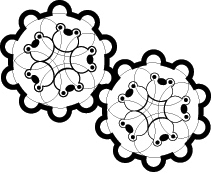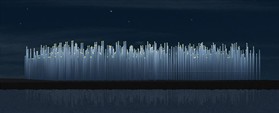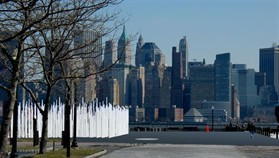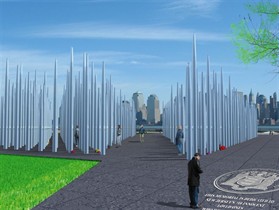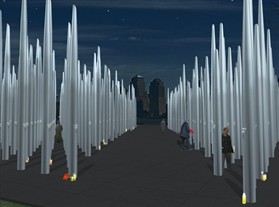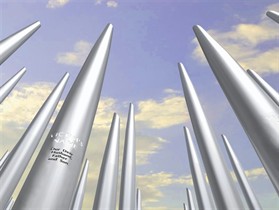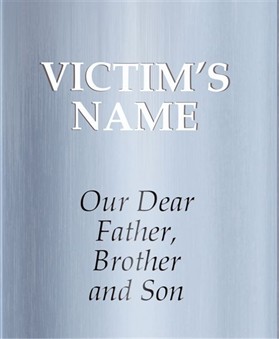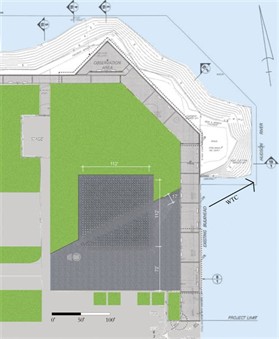В 2004 году, через 2.5 года после терактов 11 сентября, правительство штата New Jersey объявило всеамериканский конкурс на памятник жертвам трагедии - 710 жителям штата, погибшим в этот день в Нью-Йорке и Вашингтоне.
Для проектирования был предложен открытый участок в Liberty State Park на берегу р. Гудзон, находящийся напротив разрушенных башен-близнецов. Сюда все возможные плавсредства привозили в тот день людей, бегущих после падения башен из Манхеттена. С участка открывается прекрасный вид не только на Нью-Йорк, но и океан и на статую Свободы.
Отсюда же паром-челнок перевозит многих нью-джерсийцев на работу в Нью-Йорк и обратно, а туристические катера отправляются к статуе Свободы.
На конкурс было представлено 320 проектов. Профессиональное жюри отобрало 6 проектов-финалистов, предложенных для окончательного решения комитету семей погибших.
В финал конкурса был отобран наш проект <Мемориальный ветряной орган>.
Ценность человеческой жизни в развитых странах растет вместе с благосостоянием
и продолжительностью, но одновременно возникают новые возможности уничтожения и риска для жизни. Таким образом, возникла идея персонифицировать память о каждом погибшем, а не разместить их имена, как обычно, списком.
Характерной особенностью участка является его продуваемость всем ветрами. А ветер - символ свободы, главной декларируемой ценности американского общества, объекта атаки террористов.
Так появилась идея ветряного органа, состоящего из 710 (по числу погибших жителей Нью-Джерси) гудящих под порывами ветра стальных труб. Звук каждой трубы может быть настроен индивидуально, он также меняется в зависимости от направления ветра. Вертикальные прорези располагаются на трубах на различной высоте и в разных направлениях, таким образом, улавливая направления ветра. <Звучит> прорезь, когда ветер дует параллельно срезу, а тембр звука зависит от ширины и высоты щели. Сгруппировав щели определённых тональностей по определённым направлениям, возможно, создать различные звуковые симфонии, например, восточную симфонию, северную симфонию и т.д.
Каждая труба олицетворяет одного человека, на ней выгравированы его имя и слова посвящения от его семьи. Высота труб варьируется от 4 до 8м в соответствии с возрастом человека. Трубы расставлены по сетке с шагом 1.20х1.20 м и образуют квадрат около 35х35м, но не строго,
а с небольшими смещениями - так, как обычные люди находятся на своих рабочих местах в больших офисах. Квадрат прорезан проходом-просекой шириной около 4м. Просека сориентирована от подъездной дороги в сторону того места на панораме Манхеттена, где раньше стояли Близнецы.
Каждая труба имеет скошенный верх, обращенный в сторону Манхеттена, который подсвечивается встроенным светильником. Таким образом, в темное время суток со стороны Манхеттена мемориал выглядит как 710 горящих свечей.
Для проектирования был предложен открытый участок в Liberty State Park на берегу р. Гудзон, находящийся напротив разрушенных башен-близнецов. Сюда все возможные плавсредства привозили в тот день людей, бегущих после падения башен из Манхеттена. С участка открывается прекрасный вид не только на Нью-Йорк, но и океан и на статую Свободы.
Отсюда же паром-челнок перевозит многих нью-джерсийцев на работу в Нью-Йорк и обратно, а туристические катера отправляются к статуе Свободы.
На конкурс было представлено 320 проектов. Профессиональное жюри отобрало 6 проектов-финалистов, предложенных для окончательного решения комитету семей погибших.
В финал конкурса был отобран наш проект <Мемориальный ветряной орган>.
Ценность человеческой жизни в развитых странах растет вместе с благосостоянием
и продолжительностью, но одновременно возникают новые возможности уничтожения и риска для жизни. Таким образом, возникла идея персонифицировать память о каждом погибшем, а не разместить их имена, как обычно, списком.
Характерной особенностью участка является его продуваемость всем ветрами. А ветер - символ свободы, главной декларируемой ценности американского общества, объекта атаки террористов.
Так появилась идея ветряного органа, состоящего из 710 (по числу погибших жителей Нью-Джерси) гудящих под порывами ветра стальных труб. Звук каждой трубы может быть настроен индивидуально, он также меняется в зависимости от направления ветра. Вертикальные прорези располагаются на трубах на различной высоте и в разных направлениях, таким образом, улавливая направления ветра. <Звучит> прорезь, когда ветер дует параллельно срезу, а тембр звука зависит от ширины и высоты щели. Сгруппировав щели определённых тональностей по определённым направлениям, возможно, создать различные звуковые симфонии, например, восточную симфонию, северную симфонию и т.д.
Каждая труба олицетворяет одного человека, на ней выгравированы его имя и слова посвящения от его семьи. Высота труб варьируется от 4 до 8м в соответствии с возрастом человека. Трубы расставлены по сетке с шагом 1.20х1.20 м и образуют квадрат около 35х35м, но не строго,
а с небольшими смещениями - так, как обычные люди находятся на своих рабочих местах в больших офисах. Квадрат прорезан проходом-просекой шириной около 4м. Просека сориентирована от подъездной дороги в сторону того места на панораме Манхеттена, где раньше стояли Близнецы.
Каждая труба имеет скошенный верх, обращенный в сторону Манхеттена, который подсвечивается встроенным светильником. Таким образом, в темное время суток со стороны Манхеттена мемориал выглядит как 710 горящих свечей.
The belief in the value of human life in the contemporary world is growing, and at the same time the possibilities of destruction are multiplying. So as the lives of our loved ones become more fragile, they become all the more valuable.
The tragedy of September 11th unites many people in grief over the loss of those killed in the attack. At the same time, the loss of a loved one is a personal and irreplaceable tragedy
for each particular family.
That is why our original thought of honoring the victims of the 9/11 tragedies were to personalize each victim's memory rather than to list their names.
Once we arrived on the site, we realized immediately that wind was the most significant natural force present. Wind traditionally represents freedom, and that is what the terrorists were targeting.
So we came up with the idea of a wind organ consisting of the number of pipes equal to the number of victims who perished in the disaster.
Each organ-pipe is dedicated to one particular person. Therefore, every person would have his or her own voice. This memorial is an attempt to personalize the connection between the victims and visitors, in a dialogue with the wind.
The Memorial Wind Organ consists of 710 stainless steel pipes, and forms an 112 x 112 foot square on the territory of the existing plaza and lawn. Each victim's name is cut out and lit from the inside of each individual pipe.
As desired by family members, additional personal information or words of dedication may be engraved under the name on the surface of the pipe.
The square of the Organ symbolizes the two towers of the World Trade Center's floor plan. The square is divided by a passageway. The passage is a visual corridor directed toward the WTC site. Visitors, arriving at the site from New Jersey by the main access road, Audrey Zapp Drive, observe a throng of poles against the backdrop of the Manhattan skyline. As the viewer approaches the Memorial, the corridor will come into view and the WTC site will appear and reveal itself.
At the entrance to the main passage, installed into the pavement, A stainless steel plate with the seal of the State of New Jersey and words of dedication meet visitors approaching the memorial.
The organ-pipes are mounted onto the ground atop of blue slate pavers (historically the traditional pavement material used in New York)
The organ pipes are arranged in a grid of 4 by 4 feet, but shifted from perfection as to make the composition more humanistic and happenstance. Clearance between the pipes is a minimum of 38 inches, which allows a visitor to come closer to a pipe to honor their lost ones, or to contemplate.
Flowers or candles could be left beneath a Memorial pipe.
The pipes' height varies from 13 to 21 feet according to a person's age. Each pipe has a pitch on the top, Candles which shines at night so the memorial would look as a grove of candles from an arriving ferry. While the tops are turned towards Manhattan, victims' names are facing the corridor to meet the visitors.
The tragedy of September 11th unites many people in grief over the loss of those killed in the attack. At the same time, the loss of a loved one is a personal and irreplaceable tragedy
for each particular family.
That is why our original thought of honoring the victims of the 9/11 tragedies were to personalize each victim's memory rather than to list their names.
Once we arrived on the site, we realized immediately that wind was the most significant natural force present. Wind traditionally represents freedom, and that is what the terrorists were targeting.
So we came up with the idea of a wind organ consisting of the number of pipes equal to the number of victims who perished in the disaster.
Each organ-pipe is dedicated to one particular person. Therefore, every person would have his or her own voice. This memorial is an attempt to personalize the connection between the victims and visitors, in a dialogue with the wind.
The Memorial Wind Organ consists of 710 stainless steel pipes, and forms an 112 x 112 foot square on the territory of the existing plaza and lawn. Each victim's name is cut out and lit from the inside of each individual pipe.
As desired by family members, additional personal information or words of dedication may be engraved under the name on the surface of the pipe.
The square of the Organ symbolizes the two towers of the World Trade Center's floor plan. The square is divided by a passageway. The passage is a visual corridor directed toward the WTC site. Visitors, arriving at the site from New Jersey by the main access road, Audrey Zapp Drive, observe a throng of poles against the backdrop of the Manhattan skyline. As the viewer approaches the Memorial, the corridor will come into view and the WTC site will appear and reveal itself.
At the entrance to the main passage, installed into the pavement, A stainless steel plate with the seal of the State of New Jersey and words of dedication meet visitors approaching the memorial.
The organ-pipes are mounted onto the ground atop of blue slate pavers (historically the traditional pavement material used in New York)
The organ pipes are arranged in a grid of 4 by 4 feet, but shifted from perfection as to make the composition more humanistic and happenstance. Clearance between the pipes is a minimum of 38 inches, which allows a visitor to come closer to a pipe to honor their lost ones, or to contemplate.
Flowers or candles could be left beneath a Memorial pipe.
The pipes' height varies from 13 to 21 feet according to a person's age. Each pipe has a pitch on the top, Candles which shines at night so the memorial would look as a grove of candles from an arriving ferry. While the tops are turned towards Manhattan, victims' names are facing the corridor to meet the visitors.
МЕМОРИАЛЬНЫЙ ВЕТРЯНОЙ ОРГАН / THE MEMORIAL WIND ORGAN
Проект-финалист конкурса на
Мемориал жертвам 9/11 в Нью-Джерси. 2004г. Совместно
с Jason Alan Klotz
The New Jersey 911 Memorial Competition. Finalist project.
Stage Two of the competition executed in collaboration with NY based sculptor Jason Klotz
Мемориал жертвам 9/11 в Нью-Джерси. 2004г. Совместно
с Jason Alan Klotz
The New Jersey 911 Memorial Competition. Finalist project.
Stage Two of the competition executed in collaboration with NY based sculptor Jason Klotz
